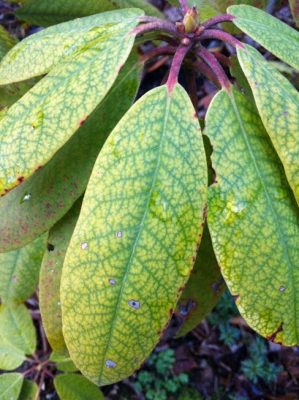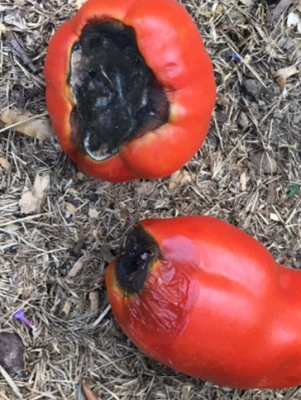Foliar feeding refers to the application of fertilizers to a plant’s leaves. It is not a substitute for maintaining adequate levels of plant nutrients in the soil but can be beneficial in certain circumstances. Most commonly, it is recommended for alleviating specific micronutrient deficiencies. In recent years, products have been developed that contain growth hormones, natural plant sugars, microorganisms and other ingredients. There is very little evidence that these products are especially effective.
Interest in foliar feeding was stimulated during the 1950’s when Dr. H.B. Tukey and Dr. S.H. Wittwer at Michigan State University, using radioactive isotopes of known plant nutrients, found that nutrients were absorbed by plant foliage and translocated throughout the plant. In some plants the rate of movement was one foot per hour! They also reported that foliar feeding resulted in about 95 percent efficiency of nutrient use versus only about 10 percent efficiency of nutrient use from soil fertilizer application. When fertilizers are applied to plant leaves, nutrients generally enter the plant through the cuticle which is a thin, waxy layer on the outside of leaves and stems, and through the stomates which are pores on the leaf and stem surfaces. Nutrients may enter from both the top and the undersides of the leaves.
It is not practical to attempt to supply nutrients that plants require in large amounts like nitrogen, phosphorus and potassium, or those that are relatively immobile such as calcium or boron, solely by foliar feeding. A concentrated spray of an element like nitrogen would likely burn or desiccate the foliage. Even frequent applications at low concentration applications would not provide enough nutrients to support growth. However, foliar applications can supplement soil nutrients and provide a small boost in growth and yield. Foliar feeding is an excellent, short term method to correct nutritional deficiencies in plants, especially those caused by micronutrients. A typical example would be its use on chlorotic rhododendrons, azaleas, blueberries and other acid-loving plants. These members of the Ericaceae family have relatively high iron requirements. While iron is typically abundant in New England soils, it is converted into an insoluble form that cannot be taken up by plants if the soil pH is too high. Plants lacking iron often show a yellowing between the veins, commonly referred to as interveinal chlorosis. Ultimately the soil pH will need to be corrected but for quick relief a foliar spray can help. A fertilizer containing either a chelated iron compound, or a fertilizer with micronutrients including iron can be mixed as directed and sprayed on the foliage.
Another situation where foliar feeding can be useful is in preventing blossom end rot, a physiological disorder that can occur in tomatoes, peppers and summer squash because of lack of calcium. Sometimes calcium is lacking in the soil and additions of limestone to raise the soil pH and add calcium would be the long term solution. During periods of drought, however, even if there are adequate amounts of calcium in the soil, the water which would transport it into the plant roots is in short supply. Thorough watering is essential to correct blossom end rot. Some growers also apply foliar sprays of a one percent calcium chloride solution to plants.
Ideally foliar feeds should be applied in the cooler morning or evening hours. It is not advisable to spray leaves during the heat of the day. The combined effects of fertilizer and sunlight on the foliage could cause tissue damage. Any time a new foliar product is applied, it makes sense to test it on a small portion of leaves before spraying the entire plant or crop. When spraying the foliage of plants, a fine mist is preferable to large droplets as greater leaf contact will be made. Remember to spray the undersides of the leaves well. Generally plants are sprayed until droplets start to drip on to the ground. To assist adherence to the foliage, add one to two drops of insecticidal soap, horticultural oil, or the recommended amount of purchased spreader sticker per gallon of foliar fertilizer.
Choices for foliar feeds are quite varied. Typically water soluble powder or liquid fertilizers are used. When purchasing these fertilizers look at the label to make sure that directions are given for a foliar application. This is often less concentrated than if the fertilizer was watered into the ground. Also, consider choosing water soluble fertilizers that have micronutrients included.
There are many naturally derived materials that are widely used as foliar fertilizers. These include seaweed, kelp, fish emulsion, compost teas, herbal teas and weed teas. Kelp is often used in foliar feeding formulations as it contains growth hormones and amino acids as well as macro‐ and micronutrients. To make compost tea, mix one part of mature compost to two parts of water. Let it sit for a week or so then drain and dilute with water until it is the color of weak tea before applying to plant foliage.
To make herbal or weed teas, pack a five-gallon full of herbs like nettle, comfrey, chamomile or yarrow, or just plain weeds and cover it with water. After 2 or 3 weeks, strain and use the extract to spray your plants with. Some experimentation might be necessary to determine the best dilution factor.


A formula that not only provides nutrients but also insect and disease protection for roses, and probably on other plants as well, is one tablespoon each liquid seaweed or kelp concentrate, insecticidal soap, bicarbonate‐based fungicide such as Remedy* and horticultural oil per gallon of water. I have found that when applied to roses on a weekly basis, the incidence of both black spot and powdery mildew is greatly reduced.
Foliar feeding is usually not the most cost or time efficient method for fertilizing plants. However, it is a very effective short term solution for certain nutrient deficiencies and perhaps, during times of stress. For those willing to experiment, anecdotal evidence suggests it can improve plant health and performance in certain circumstances.
By Dawn Pettinelli, Associate Extension Educator, PSLA, 2007, Revised 2023.
Questions? Contact:
UConn Soil Nutrient Analysis Laboratory
Department of Plant Science and Landscape Architecture
Phone: 860.486.4274
Email: soiltest@uconn.edu
Website: soiltesting.cahnr.uconn.edu
UConn is an equal opportunity program provider and employer.
©UConn Extension. All rights reserved.